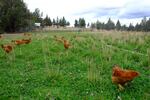Farming is a family affair for Cameron Gunther. His parents were farmers, and he now runs a small poultry farm, Home Farm Foods, with his mother in Culver, Oregon. Their 4,000 chickens can produce up to 250 dozen eggs every day. That may sound big, but Gunther says that doesn’t translate into a big cushion for unexpected problems.

Chicken's graze at Rainshadow Organics farm in Sisters, Oregon in this file photo. Nearby, Bend poultry farms were put under quarantine for avian flu on July 11.
Sage Van Wing / OPB
“We don’t have these huge savings accounts that these big farms have,” Gunther said. He made the tough choice to close access to his farm after a form of avian flu, that can be deadly for wild birds and poultry, was found in the nearby city of Bend.
“If we went positive for avian I think we would go under,” Gunther said.
For Gunther, it was voluntary. Farms within 10 kilometers of infected property fall within a quarantine zone, which covers most of Bend. Nearby poultry farmers outside of that area may also take preventative measures.
The challenges Gunther and other poultry owners now face come after the Oregon Department of Agriculture issued a regional quarantine for avian influenza for Deschutes County this week. It was the fifth confirmed case in the state this year. Dr. Ryan Scholz, state veterinarian for the Oregon Department of Agriculture, says the strain of avian influenza detected in Bend differs from a less-severe strain typically found in Oregon.
“What we’re dealing with right now is what we call a highly pathogenic strain of avian influenza where instead of just making birds a little bit sick, the highly pathogenic strains will kill the birds outright very, very quickly,” Scholz said.
These strains are uncommon in the U.S., Scholz said. “We’ve only had one other large outbreak of a strain of highly pathogenic avian influenza here in the U.S., and that was in 2015,” Scholz said.
But in the Pacific Northwest, the strain has been running rampant. Washington has already had 28 cases detected in domestic flocks.
The virus was found in a flock of roughly 70 birds in eastern Bend where owners sold eggs to the public. Because the virus quickly kills poultry, the Department of Agriculture issues regional quarantines after detection and euthanizes all birds exposed to the virus.
According to Scholz, during the quarantine, the department conducts two rounds of surveillance with 14 days in between.
“If we find any more cases within that control area, then that quarantine gets extended and we have to start over again.”
Gunther, whose farm is in Jefferson County some distance from the mandatory quarantines near Bend, restricted farm access at first because of cases in Washington. He fully closed his farm to visitors as a preventative measure following the quarantine announcement on Tuesday.
“Anybody that doesn’t work for us immediately no longer has access to the farm,” Gunther said. “We’ve completely shut it down.”
These quarantines burden poultry farmers, especially those like Gunther who rely on his birds having outdoor access. His facilities currently cannot handle a full quarantine – which requires isolating birds indoors.
“If all those birds were to go inside, and we have to lock all the vents, all the fans, all the doors…, the heat in there would just be too much,” Gunther said. “I would suggest or guess that we would probably lose 30-40% from heat stroke.”
These preventative measures also place a financial strain on farmers like Gunther, who said, “Even when you do test positive for avian, the help is a joke.” While the USDA will offer compensation for euthanized poultry, cleaning and equipment disposal, losses from business disruption cannot be covered. Already, Gunther has felt the impact of his self-quarantine. Deliveries, usually done two to three times a week, are only being done once. A full quarantine, he said, would be devastating to the farm and its staff.
“If we went on the full lockdown, we’d probably have to let go of three of our five guys,” He said.
To prevent avian flu from spreading, Scholz said, “The biggest thing is making sure that wild waterfowl do not come into contact with domestic birds.” Other preventative measures include cleaning equipment and clothing that comes in contact with other domestic and wild birds, as the virus spreads from bird to bird contact.
As summer progresses, the warmer weather should help mitigate the virus. However, Scholz still encourages flock owners to be mindful of avian influenza.
“I fully expect this virus to be back in the fall when the weather cools off and the birds start flying through again,” Scholz said. “So it’s going to be really important that poultry owners take a good look at their operations right now and figure out what they can implement to protect their own birds.”
If you suspect wild or domesticated birds to have avian influenza, contact the Oregon Department of Agriculture immediately. Symptoms include sudden death, swelling around the head, discoloration, coughing, sneezing, diarrhea, lack of energy and decreased appetite.